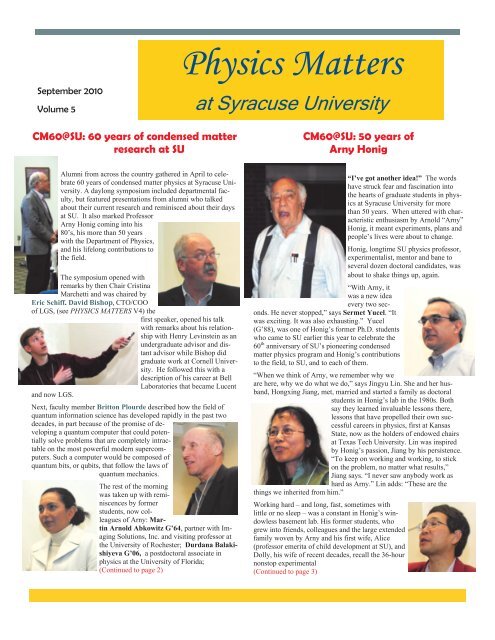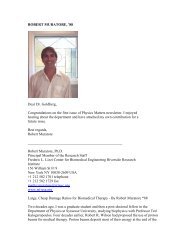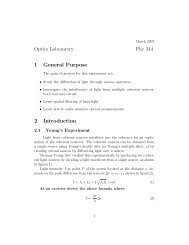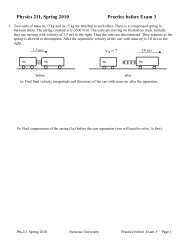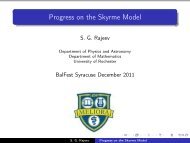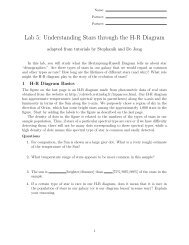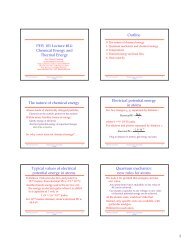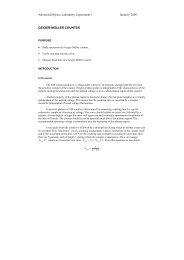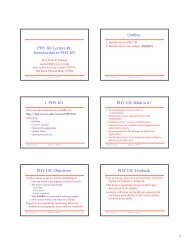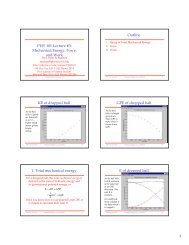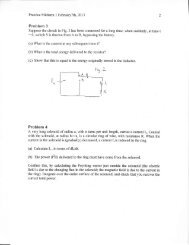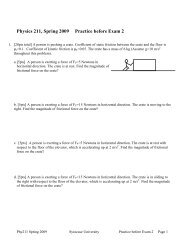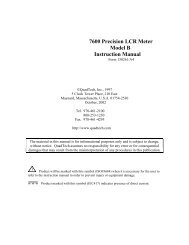Volume 5 - Physics - Syracuse University
Volume 5 - Physics - Syracuse University
Volume 5 - Physics - Syracuse University
You also want an ePaper? Increase the reach of your titles
YUMPU automatically turns print PDFs into web optimized ePapers that Google loves.
<strong>Physics</strong> Matters<br />
September 2010<br />
<strong>Volume</strong> 5<br />
at <strong>Syracuse</strong> <strong>University</strong><br />
CM60@SU: 60 years of condensed matter<br />
research at SU<br />
CM60@SU: 50 years of<br />
Arny Honig<br />
Alumni from across the country gathered in April to celebrate<br />
60 years of condensed matter physics at <strong>Syracuse</strong> <strong>University</strong>.<br />
A daylong symposium included departmental faculty,<br />
but featured presentations from alumni who talked<br />
about their current research and reminisced about their days<br />
at SU. It also marked Professor<br />
Arny Honig coming into his<br />
80’s, his more than 50 years<br />
with the Department of <strong>Physics</strong>,<br />
and his lifelong contributions to<br />
the field.<br />
The symposium opened with<br />
remarks by then Chair Cristina<br />
Marchetti and was chaired by<br />
Eric Schiff. David Bishop, CTO/COO<br />
of LGS, (see PHYSICS MATTERS V4) the<br />
first speaker, opened his talk<br />
with remarks about his relationship<br />
with Henry Levinstein as an<br />
undergraduate advisor and distant<br />
advisor while Bishop did<br />
graduate work at Cornell <strong>University</strong>.<br />
He followed this with a<br />
description of his career at Bell<br />
Laboratories that became Lucent<br />
and now LGS.<br />
Next, faculty member Britton Plourde described how the field of<br />
quantum information science has developed rapidly in the past two<br />
decades, in part because of the promise of developing<br />
a quantum computer that could potentially<br />
solve problems that are completely intractable<br />
on the most powerful modern supercomputers.<br />
Such a computer would be composed of<br />
quantum bits, or qubits, that follow the laws of<br />
quantum mechanics.<br />
The rest of the morning<br />
was taken up with reminiscences<br />
by former<br />
students, now colleagues<br />
of Arny: Martin<br />
Arnold Abkowitz G’64, partner with Imaging<br />
Solutions, Inc. and visiting professor at<br />
the <strong>University</strong> of Rochester; Durdana Balakishiyeva<br />
G’06, a postdoctoral associate in<br />
physics at the <strong>University</strong> of Florida;<br />
(Continued to page 2)<br />
“I’ve got another idea!” The words<br />
have struck fear and fascination into<br />
the hearts of graduate students in physics<br />
at <strong>Syracuse</strong> <strong>University</strong> for more<br />
than 50 years. When uttered with characteristic<br />
enthusiasm by Arnold “Arny”<br />
Honig, it meant experiments, plans and<br />
people’s lives were about to change.<br />
Honig, longtime SU physics professor,<br />
experimentalist, mentor and bane to<br />
several dozen doctoral candidates, was<br />
about to shake things up, again.<br />
“With Arny, it<br />
was a new idea<br />
every two seconds.<br />
He never stopped,” says Sermet Yucel. “It<br />
was exciting. It was also exhausting.” Yucel<br />
(G’88), was one of Honig’s former Ph.D. students<br />
who came to SU earlier this year to celebrate the<br />
60 th anniversary of SU’s pioneering condensed<br />
matter physics program and Honig’s contributions<br />
to the field, to SU, and to each of them.<br />
“When we think of Arny, we remember why we<br />
are here, why we do what we do,” says Jingyu Lin. She and her husband,<br />
Hongxing Jiang, met, married and started a family as doctoral<br />
students in Honig’s lab in the 1980s. Both<br />
say they learned invaluable lessons there,<br />
lessons that have propelled their own successful<br />
careers in physics, first at Kansas<br />
State, now as the holders of endowed chairs<br />
at Texas Tech <strong>University</strong>. Lin was inspired<br />
by Honig’s passion, Jiang by his persistence.<br />
“To keep on working and working, to stick<br />
on the problem, no matter what results,”<br />
Jiang says. “I never saw anybody work as<br />
hard as Arny.” Lin adds: “These are the<br />
things we inherited from him.”<br />
Working hard – and long, fast, sometimes with<br />
little or no sleep – was a constant in Honig’s windowless<br />
basement lab. His former students, who<br />
grew into friends, colleagues and the large extended<br />
family woven by Arny and his first wife, Alice<br />
(professor emerita of child development at SU), and<br />
Dolly, his wife of recent decades, recall the 36-hour<br />
nonstop experimental<br />
(Continued to page 3)
2<br />
50 years of condensed matter continued<br />
Mouqun Dong G’ 96 a microwave engineering consultant in the San Francisco area; Hongxing<br />
Jiang G’86, the Edward E. Whitacre, Jr. Endowed Chair and Professor of Electrical and<br />
Computer Engineering at Texas Tech <strong>University</strong>; Jingyu Lin G’89, the Linda F. Whitacre<br />
Endowed Chair and Professor of Electrical and Computer Engineering, Texas<br />
Tech ,<strong>University</strong>; Xiangdong Wei G’94, staff scientist at the Thomas Jefferson National Accelerator<br />
Facility/Jefferson Lab in Newport News, Virginia; Jay Zemel ’49, G’56, H. Nedwill<br />
Ramsey Professor (Emeritus) of Sensor Technologies, Department of Electrical Engineering,<br />
<strong>University</strong> of Pennsylvania; Sermet Yucel G’88, President and Founder and Chief Technical<br />
Officer of Certusoft in Edina, MN.<br />
After lunch, the symposium continued with a talk by Mark Reed, Harold Hodgkinson Chair of Engineering and Applied<br />
Science at Yale <strong>University</strong>. Mark emphasized that the scaling of charge-based devices is projected to reach its limits in<br />
the next decade, and a search is underway for successors. He reviewed the physics and scaling<br />
of present transistor device technology, and discussed the factors that will limit future device<br />
and system scaling. Also reviewed are current developments in the area of atomic and molecular-scale electronic systems,<br />
where transistors operating by the action of a single electron, or made from a single molecule, have been achieved.<br />
Interestingly, the ultimate limit of transistor scaling comes from an unanticipated direction, namely the heat dissipation of<br />
switching devices. This realization points to a new potential research direction, bioelectronic interfaces and systems.<br />
Mark was followed by faculty member Matt LaHaye who spoke on efforts to span several fields within physics to combine<br />
quantum technologies with mechanical systems for the development of ultra-sensitive detectors and for explorations<br />
of fundamental physics. A central focus in this effort, dubbed quantum electromechanical systems, has been the integration<br />
of solid-state quantum electronic devices with nanoelectromechanical systems (NEMS).<br />
The afternoon concluded with Arny giving an interesting and amusing review of his research in<br />
his 56 years in the physics department.<br />
A gala banquet in the <strong>University</strong>’s new Life Sciences Complex Atrium closed out the day. On Sunday, guests continued<br />
their celebration on Honig’s farm in Oran.<br />
“The weekend was both entertaining and enlightening,” says Eric Schiff, physics professor and former associate dean for<br />
sciences and mathematics in The College of Arts and Sciences. “It was fascinating to hear about the kind of work our<br />
alumni are engaging in all across the country. The anecdotes about the years they spent on campus brought back special<br />
memories for us all as we laughed and shared our stories.”<br />
With contributions from Judy Holmes<br />
Pictures by Steve Sartori
3<br />
50 years of Arny Honig continued<br />
marathons, the 4 a.m. phone calls – “I want to know the results!” – the flood of words and ideas, the contagious energy and<br />
raw power of Honig’s personality, with equal parts awe, gratitude, and pride that they survived years working with him.<br />
“Arny almost killed me,” says Xiangdong Wei (G’94), who spent 10 years in Honig’s lab, first as a doctoral student, then<br />
post-doc. Their collaboration has continued another decade, as Wei moved with his nuclear target experiments and gear from<br />
Honig’s lab to Brookhaven National Laboratory on Long Island, then Thomas Jefferson National Lab in Virginia.<br />
“Sometimes, you wanted to hate him,” Wei says of Honig. “But you couldn’t. You had to love him.”<br />
Born in the Bronx and educated at Cornell and Columbia <strong>University</strong>, where he earned his Ph.D.,<br />
Honig came to SU in 1956 after post-doc stints at Berkeley and in Paris. He came because he could<br />
set up his own lab and because no group was yet working in his specialty – low-temperature solidstate<br />
physics. He wanted to run his own show.<br />
“This was hot times for solid-state transistors and electronics,” Honig says. “And we were right at<br />
the frontier.” He and fellow SU physicists Henry Levinstein and Mel Lax were in the first wave of scientists exploring the<br />
behaviors of atomic particles and how these manifested in the properties of certain solids, including silicon. As the field<br />
grew it broadened to include other states – liquids, gels, crystals – and was renamed condensed matter physics.<br />
Honig’s lab grew, too. He went from one room with a grad student or two in the basement of Steele Hall to five rooms and<br />
as many as 10 associates under the old Archbold Stadium and in the new <strong>Physics</strong> Building. Government and foundation<br />
grants grew from thousands to hundreds of thousands of dollars. Honig’s group was doing the basic science – solving problems,<br />
building equipment, conducting experiments – that would lead to major developments in computer (semiconductors),<br />
medical (NMR and MRI) and nuclear (fusion and fission) technologies.<br />
They built some big machines to do it.<br />
“We had to cut holes in the ceiling and dig pits in the floor” to make room for a massive dilution refrigerator and its attendant<br />
superconductor magnets for experiments with polarized hydrogen deuteride (HD). When a bigger experiment<br />
required more polarized HD, they built a bigger machine, and cut bigger holes and dug deeper pits.<br />
“I always liked big machinery,” Honig says, and chuckles.<br />
His deep voice still echoes the broad, nasal tone of the Bronx. And while he stays current with the small-scale physics of<br />
today, the nanotechnology, nanostructures, and nanoexperiments – “You can do four or five experiments on a countertop!”<br />
– Honig is glad he was part of the outsized “cowboy physics” era, “when we were hanging from ladders at 4 a.m.<br />
and jamming hot rods<br />
into blocks of ice to<br />
break them.”<br />
He has won the admiration<br />
of his colleagues<br />
for his commitment to the field, loyalty<br />
to students, and enthusiasm for pursuing pure<br />
science at its deepest levels.<br />
“He’s just a guy who is 100 percent committed<br />
to doing interesting science,” says Eric Schiff, a<br />
professor in SU’s physics department for 29<br />
years. “I’m sure that the day he dies, he’s going<br />
to write down his next possible Nobel Prizewinning<br />
idea.”<br />
Don’t let his Emeritus status fool you. At 82,<br />
Arny Honig is far from done.<br />
“I still have some very interesting experiments<br />
I’m planning to do,” he says. He could use a<br />
grad student or two. “Oh, I’ve got some ideas,”<br />
he says, nodding and smiling.<br />
Sitting there in Honig’s small, book- and paperstuffed<br />
office in the <strong>Physics</strong> Building, you<br />
could almost hear generations of grad students<br />
sigh.<br />
James Reilly, freelance writer. To appear in the fall<br />
issue of Arts & Sciences, the college’s new alumni<br />
magazine.
4<br />
From the Editor<br />
This issue reports on a transition in departmental leadership. On the next page you will note that Cristina Marchetti has<br />
stepped down as Chair because of her increasing involvement in her research. Peter Saulson, in spite of being deeply<br />
involved with the LIGO effort, has graciously agreed to assume the responsibility as Chair. We are all grateful for Cristina’s<br />
service and look forward to further accomplishment under Peter.<br />
You will note that there is an emphasis in this issue on the undergraduates. In part it is a continuation of the importance<br />
of teaching together with introducing undergraduates into the research laboratories. This year, the increase in the research<br />
funding , remarked on by both Cristina and Peter, has led to a larger number of students in the research laboratories.<br />
It seemed reasonable that should be rewarded by being explicitly noted in this issue.<br />
I also want to call your attention to two brief articles. One is a brief item about Willian Pratt Graham, Chancellor 1937-<br />
42, who studied physics in Germany and had classes with Max Planck and other noted physicists of the late 19 th century.<br />
Although his main contribution at SU was in electrical engineering, he remained interested in physics and aware<br />
of developments into the mid 20 th century. The other is a brief biography of Joel Lebowitz who did his dissertation here under Peter Bergmann and<br />
who is a member of the National Academy of Science among other received awards.<br />
Please enjoy reading about the accomplishments of the<br />
faculty and the other bits of news that makes up this issue.<br />
We always enjoy hearing from you so please keep up the<br />
correspondence and tell us what you have been doing and<br />
how what you learned here was important in understanding<br />
your world if not your work.<br />
Society of <strong>Physics</strong> Students<br />
Lianxin He<br />
This semester SPS divided its work into different series devoted<br />
for the academic lives of our physics majors at SU. On<br />
monthly Tuesday Nights, we had pizza while an SU professor<br />
talked about his research. In February, Prof. Duncan<br />
Brown lectured us on the basics of gravitational waves and<br />
how to detect them; in March, Prof. Jay Hubisz introduced to<br />
us the basics of particle physics; in April, Prof. Martin<br />
Forstner discussed topics like self-assembly, cell membranes,<br />
and nano technology; and also in April, Prof. Eric Schiff talked us about the Green<br />
House Effect, Environmental Technology, and his research on solar cells.<br />
TABLE OF CONTENTS<br />
CM60@SU: 60 years of condensed matter research at<br />
SU……………………………………………...1<br />
CM60@SU: 50 years of Arny Honig………………...…..1<br />
From the Editor………………………………………..….4<br />
Society of <strong>Physics</strong> Students……………………...…….....4<br />
Peter Saulson, Chair…………………………………..…..5<br />
Cristina Marchetti, Past Chair………………………….....5<br />
Faculty News………………………………………..…....6<br />
Superconducting Qubits at the Quantum Frontier………...7<br />
Mitchell Soderberg…………………………………….….8<br />
Lou Buda……………………………………………....….8<br />
Duncan Brown………………………………………...….8<br />
Solar Cells……………………………………………..….9<br />
<strong>University</strong> Archives Looks to Expand its <strong>Physics</strong><br />
Holdings………………………………..….….10<br />
AAPT Meeting, October 16-17………………………....11<br />
4th Undergraduate Research Day and Open House….….11<br />
Undergraduate Students in the Research Labs…………..12<br />
Undergraduate Awards…………………………………..12<br />
News & Notes …………………………………………..13<br />
Correspondence From Alumni………………………….14<br />
Degrees Granted—2010………………………………...15<br />
Contributions…………………………………………….16<br />
On occasional Thursdays, we met the guest colloquium speakers to discuss their research<br />
and ask questions so that we undergraduate students can really appreciate their<br />
work. On March 4, Mark Trodden from <strong>University</strong> of Pennsylvania talked to us about<br />
dark energy and dark matter, asymmetry of the universe, multidimensional theories,<br />
and super symmetric theories; On April 8, Professor Jeevak Parpia from Cornell<br />
<strong>University</strong> talked about experiments on glasses at low temperature; on April 15, Michael<br />
Brenner from Harvard <strong>University</strong> talked about Self- Assembly and taught us<br />
some basic thermodynamics; on April 29, Professor Chris Jarzynski from <strong>University</strong><br />
of Maryland also talked on thermodynamics and explained his "Jarzynski Equality"<br />
which has revolutionized the field of single molecule biophysics.<br />
We also had lunch with Professors Schiff and Saulson who talked about their career<br />
choices and shifts. This was interesting because it opened up possibilities other than<br />
strictly academic or strictly industrial opportunities.<br />
On March 5 we watched the entertaining show The Big Bang Theory together with<br />
students from all over the campus, Afterward, David Saltzberg, the physics advisor<br />
for the show, enthusiastically talked with us for an hour through Skype.<br />
Lastly, we organized a couple trips. We visited the Cornell campus, the Johnson<br />
Museum of Art, and the nearby Buttermilk Falls. From April 2-4, SPS visited Boston.<br />
Prof. Schnee first gave us a lecture on Dark Matter Detector to prepare us for the<br />
MIT lab tour. Then we visited the Museum of Science at Boston, and had lunch together<br />
with physics majors from Northeastern <strong>University</strong>, MIT, Boston <strong>University</strong><br />
and U-Mass. Later guided by Kevin, a graduate student at MIT, we visited MIT laser<br />
lab and astrophysics lab on Chandra. At last we visited another MIT lab dedicated to<br />
dark matter detecting.
5<br />
Peter Saulson, Chair<br />
I am pleased to greet you all for the first time as Chair of the <strong>Syracuse</strong> <strong>University</strong> Department of <strong>Physics</strong>. I’m honored<br />
(and a bit humbled) to be succeeding Cristina Marchetti, who has led the Department so ably for the past three years. It<br />
is a pleasure to acknowledge the hard and skillful work of our dedicated staff. It is most helpful to me that Alan Middleton<br />
has agreed to continue to serve as Associate Chair and that Steve Blusk and Simon Catterall have agreed to be<br />
in charge of Undergraduate and Graduate Studies, respectively. Last but not least, I’m proud to be a part of a community<br />
of people for whom research, teaching and the learning of physics are a value that unites us as a community.<br />
These are exciting times for physics, and exciting times for us in the Department. This fall, we greeted three new faculty<br />
members:<br />
Arriving this fall, although hired last year, are Stefan Ballmer and Scott Watson. Stefan comes to us from Caltech,<br />
where he became one of the world’s experts in the delicate interferometric detection technology at the heart of the<br />
LIGO gravitational wave detector. Scott, most recently at Michigan, is an outstanding theoretical cosmologist. He is<br />
particularly interested in the intimate connection between cosmology and particle physics<br />
Mitch Soderberg arrives in an innovative joint appointment with Fermilab, where he will continue to serve in a half time position. Mitch will be<br />
the point man for our very strong high energy group’s effort to develop a new research focus in neutrino physics.<br />
So you can see that we are blessed with the chance to enhance some of our traditional strengths at the frontiers of the physics of the very large and<br />
the very small. But there is excitement throughout the Department, with a palette of research efforts across a wide spectrum of today’s physics frontiers.<br />
We’re proud, too, of our very strong programs of undergraduate and graduate education, and as members of a vibrant <strong>University</strong>. You’ll know<br />
a lot about this from reading the pages of this Newsletter, and we are committed to keeping you informed.<br />
I hope that you, in turn, will keep in touch with us, sharing news of where life has taken you. We want you to consider your connection to the Department<br />
as an ongoing part of your life.<br />
Cristina Marchetti, Past Chair<br />
June 2010 marked the end of my term as department chair. The<br />
past three years have been challenging and rewarding. There<br />
have been many positive changes for our department, made possible<br />
thanks to the support I received from faculty and upper<br />
administration, from our excellent staff, who carries out the daily<br />
department administration with exceptional care and teamwork,<br />
and from our Associate Chair, Alan Middleton. There have also<br />
been a few setbacks, and for those I take full responsibility.<br />
Six new faculty members have joined our ranks during the past<br />
three years. The newest hire is Mitch Soderberg, who will start<br />
in Fall 2010 with a position shared between <strong>Syracuse</strong> and Fermilab.<br />
Unfortunately, we have also experienced losses. Mark Trodden<br />
left in 2009 to join the faculty at the <strong>University</strong> of Pennsylvania.<br />
We are happy to see that Mark continues to visit his former<br />
colleagues and friends in <strong>Syracuse</strong>. Sean Xing just left us to<br />
take on a position at Jiao Tong <strong>University</strong> in Shanghai. I wish<br />
him great success.<br />
The department has made enormous strides in strengthening its<br />
research program. This year our sponsored expenditures exceeded<br />
$4.5M, a 30% increase over last year. Thanks to Liviu<br />
Movileanu, we saw the first NIH grant awarded to our department<br />
in 2009. Britton Plourde has had enormous success at raising<br />
funds for his research on devices for quantum computing<br />
(see page 7).<br />
The increase in funding was accompanied by a steep growth in<br />
the number of postdocs. We now have over twenty research<br />
associates who greatly add to our intellectual vitality.<br />
Our graduate program has thrived under the stewardship of Mark<br />
Bowick, Director of Graduate Studies. We now<br />
have about 70 graduate students, a 35% increase<br />
compared to three years ago. For this we<br />
also have to thank our graduate admission committee,<br />
headed by Tomasz Skwarnicki. Our<br />
graduate students are a very active group, with<br />
frequent seminars and journal club meetings.<br />
This year we were able to reopen the graduate<br />
lounge, equipped with a pool table (for important<br />
experiments in classical mechanics).<br />
Our commitment to undergraduate education<br />
remained strong under the direction of Peter<br />
Saulson, now departmental chair. The BS track continues to attract students<br />
bound to graduate school, while the BA track is selected by students interested<br />
in a wide range of pursuits. The students continue to enjoy a strong<br />
sense of community with their Society of <strong>Physics</strong> pizza meetings and now<br />
have their own lounge with sofas, gourmet coffee machine, blackboards,<br />
computers and wireless connection.<br />
CM60 featured on page one brought back to campus many alumni in a<br />
moving celebration of Arny Honig’s career and Henry Levinstein’s legacy.<br />
Thanks to all who were able to come – it was wonderful to see you and<br />
hear your stories! Finally, I express my thanks to all our alumni who continue<br />
to provide much needed help and support. Your contributions are<br />
essential for attracting and retaining stellar students and faculty through<br />
fellowships and chairs, and take on even more urgency in times of diminishing<br />
resources.<br />
In closing, I would like to extend a warm thanks to Peter Saulson for agreeing<br />
to take on the department’s leadership for the next three years and wish<br />
him a wonderful ride.
6<br />
Faculty News<br />
Liviu Movileanu received an award<br />
from the NIH in the amount of<br />
$1,75M for five years. This is a single-PI<br />
award from the National<br />
Nanotechnology Initiative Program<br />
for a project entitled<br />
“Engineered Nanopores for Single-<br />
Molecule Stochastic Sensing”, The<br />
funding will be used to expand ongoing<br />
research to find new ways to<br />
treat leukemia and to develop new<br />
nanotechnologies that can detect<br />
diseases, including cancers, at earlier<br />
stages than currently possible.<br />
Marina Artuso has received a new NSF MRI award for<br />
"Development of hybrid pixel modules for higher luminosity<br />
operation of the LHCb experiment - ARRA." The higher sensitivity<br />
of these pixels permits the selection of interesting<br />
events in real time, allows significant improvements in the<br />
track reconstruction algorithm, and improves the collection<br />
rate of hadronic B mesons decays significantly. The award is<br />
for a total of $770,000 over 3 years, including cost-sharing.<br />
Simon Catterall is a<br />
member of the LQCD<br />
project to fund supercomputing<br />
for US lattice<br />
gauge theory. Its grant,<br />
renewed for $18,000,000<br />
over five years for new<br />
hardware, supports the<br />
collaboration of 150<br />
physisicts at many institutions. No<br />
money flows to <strong>Syracuse</strong> <strong>University</strong>, but<br />
we end up with access to the supercomputers<br />
that are bought and maintained at<br />
Fermilab\Jlab.<br />
Sheldon Stone and Graduate student Alessandria<br />
Borgia visited Weedsport High School. Alessandria<br />
gave a presentation on High Energy <strong>Physics</strong><br />
the LHC machine and the LHCb experiment. The<br />
class was then called from the LHCb control room<br />
and was given an update on the status of the LHC<br />
and the LHCb experiment: the machine is running<br />
and the experiment is producing data.<br />
Alan Middleton and Emeritus faculty<br />
Allen Miller organized<br />
“<strong>Physics</strong> in Your Future”, held on<br />
October 17, 2009. This event aimed<br />
to present our undergraduate programs<br />
in physics to high school<br />
students, their teachers and parents.<br />
About 25 students from various local<br />
schools attended, some with parents<br />
and teachers.<br />
Ken Foster and Juree Saranak received a new NSF award for the study "Self-Organizing Ciliary<br />
Beating and its Control in Chlamydomonas." This is a joint project with Ashok Sangani of Biomedical<br />
and Chemical Engineering and Hiroshi Higuchi of Mechanical and Aerospace Engineering. During<br />
their trip to Thailand in winter 2010, Ken and Juree met with the Dean of the Faculty of Science<br />
and the Chair of <strong>Physics</strong> of King Mongkut's <strong>University</strong> of Technology Thonburi (KMUTT) on establishing<br />
an international Biological/Medical <strong>Physics</strong> program in collaboration with <strong>Syracuse</strong> <strong>University</strong>.<br />
A.P. Balachandran has written a book with G. Marmo<br />
and S. Jo, ‘Group Theory and Hopf Algebras: Lectures<br />
for Physicists’ that has been sent for publication to<br />
World Scientific. In India, Bal gave lectures on<br />
'Classical Topology and Quantum States' at the Institute<br />
of Mathematical Sciences, Chennai and on ‘Bringing up<br />
a Quantum Baby’ at the Indian Institute of Technology,<br />
Kanpur.<br />
Kameshwar C. Wali has had two books published in the past year.<br />
One is about the developer of Bose-Einstein statistics:<br />
Satyendra Nath Bose, His Life and Times. It<br />
has a brief biographical sketch followed by a selection<br />
of published papers and ending with comments<br />
by A. Pais and others on the importance of Bose’s<br />
contribution. The other is Cremona Violins: A<br />
Physicist's Quest for Secrets of Stradivari a book<br />
about the violin, based on the work of Jack Fry at<br />
the <strong>University</strong> of Wisconsin.<br />
For more information see http://www.phy.syr.edu/<br />
Jay Hubisz has been added as co-PI to the<br />
<strong>Syracuse</strong> particle theory group grant from<br />
DOE. This grant of $55k annually will support<br />
Jay's research on particle physics at the<br />
TeV scale. He will support research at the<br />
Large Hadron Collider by probing the way<br />
in which nature breaks symmetries through<br />
model building and in designing experimental<br />
analyses.<br />
Tomasz Skwarnicki has been serving on the <strong>Physics</strong><br />
Advisory Committee for the Belle experiment – an<br />
electron-positron experiment looking for parity violations<br />
in B meson decay. Belle is located at KEK,<br />
major laboratory in Tsukuba, Japan. These experiments<br />
are looking for physics beyond the standard<br />
model and will be complementary to those done with<br />
pp scattering at the LHC.
7<br />
Superconducting Qubits at the Quantum Frontier (at <strong>Syracuse</strong>)<br />
Matt LaHaye and Britton Plourde<br />
Both quantum computing and quantum mechanical measurements make use<br />
of new technologies that enhance our ability to engineer and control quantum<br />
systems.. These technologies use bits of quantum information called “qubits”<br />
- nanofabricated devices based on superconducting tunnel junctions, or<br />
Josephson junctions. Depending on the size and configuration of these<br />
junctions, qubits can be realized with different macroscopic degrees of<br />
freedom, such as charge or flux.<br />
Qubits are important in quantum computing because, unlike the classical bits<br />
in a conventional computer that can only take on the familiar two states zero<br />
or one, qubits follow the laws of quantum mechanics and can exist in multiple<br />
states simultaneously, thus allowing a quantum computer to perform multiple<br />
calculations at once. Such a quantum computer could solve problems that are<br />
completely intractable on even the most powerful modern supercomputers.<br />
Despite this exciting promise, the development of large-scale architectures of<br />
many qubits that could lead to a practical quantum computer is still in its<br />
early stages.<br />
To fabricate the superconducting qubits, researchers make extensive use of<br />
the Cornell NanoScale Facility for a variety of lithographic patterning and<br />
thin-film etch processing. Plourde’s group has also developed custom vacuum<br />
systems for depositing superconducting thin films for the devices. The circuits<br />
are probed at temperatures well below 1 K in various cryogenic systems with<br />
measurements of weak microwave signals that interact with the devices. The<br />
group is working to develop quantum-limited amplifiers in the microwave<br />
range for efficient measurements of entanglement between superconducting qubits and single microwave photons. They<br />
will also be part of a team led by IBM to develop architectures with multiple superconducting qubits to implement a<br />
quantum algorithm. This work is being supported by the Defense Department.<br />
Figure 2: Superconducting qubit coupled to a flexural nanomechanical<br />
resonator, from LaHaye’s work as a postdoc in the Roukes group<br />
at Caltech. Here the qubit is a superconducting charge qubit, and the<br />
nanoresonator is the in-plane fundamental flexural mode of the suspended<br />
structure. The two systems were coupled through their mutual<br />
capacitance. In analogy to the dispersive shifts seen in CQED,<br />
the capacitive interaction resulted in a shift in the nanomechanical<br />
frequency that dependend on the qubit state. LaHaye and colleagues<br />
used the qubit-state-dependent shift to perform various measurements<br />
of the qubit, including spectroscopy of the qubit’s energy<br />
levels and observation of quantum interference between the qubit<br />
Figure 1: Electromagnetic resonator in which electrical currents<br />
and voltages oscillate at microwave frequencies formed<br />
from a superconducting aluminum thin film on a dielectric<br />
sapphire substrate for quantum information experiments. Such<br />
circuits can be coupled to superconducting qubits for exchanging<br />
quanta when the resonance frequency matches the qubit<br />
energy level spacing. Serpentine layout necessary for fitting the<br />
resonator into a convenient chip package. Patterning and etching<br />
of film performed by members of the Plourde group at the<br />
Cornell NanoScale Facility. Devices are measured at temperatures<br />
around 300 millikelvin in the Plourde lab at <strong>Syracuse</strong><br />
with resonances in the range of several gigahertz and quality<br />
factors well over 10,000.<br />
Because the spacing between the qubit’s energy levels falls in the<br />
microwave range, it enables the devices to be interfaced with state-of-theart<br />
microwave technology, including superconducting microwave<br />
resonators. Over the last half-decade, effort has been focused on the<br />
integration of qubits and resonators with measurements at temperatures<br />
below 50 mK. This has led to high fidelity preparation and control of the<br />
qubits and enabled beautiful demonstrations of quantum states of<br />
microwave light (‘cavity-QED on a chip’ or circuit QED).<br />
The micron size-scale and macroscopic degrees-of-freedom have also<br />
made these qubits amenable for coupling to nanomechanical and<br />
micromechanical motion. It has been recognized that such qubit-coupled<br />
mechanical systems could provide a mechanical analogue to cavity-QED<br />
(quantum electromechanics or QEM) and enable the observation of<br />
quantum signatures in the behavior in mechanics, including energy<br />
quantization and state superposition. Experimental results have<br />
demonstrated this formal analogy. Recently, the Cleland and Martinis<br />
groups at UCSB made the first demonstration of energy quantization and<br />
single phonon control in a micromechanical system. At <strong>Syracuse</strong>, Matt<br />
LaHaye is developing experiments to integrate superconducting qubits and<br />
microwave technology into nanoelectromechanical systems to implement<br />
new quantum measurement techniques and study the interplay of<br />
mechanical and electronic degrees of freedom at the nanoscale. These results serve as a test-bed for studying quantum mechanics in<br />
an entirely new limit.
8<br />
Mitchell Soderberg<br />
Mitchell Soderberg’s research focuses on neutrinos and<br />
new detection techniques for studying these elusive particles.<br />
Within the past decade we have learned that neutrinos<br />
can oscillate from one flavor to another, implying that<br />
they are not massless particles as initially had been<br />
thought. Numerous experiments have since been conducted<br />
to measure the manner in which neutrinos oscillate,<br />
and to understand the larger implications of this phenomenon,<br />
such as whether possible differences in the<br />
oscillations of neutrinos and antineutrinos are responsible<br />
for the observed matter-antimmater imbalance in the universe.<br />
As a postdoc at Yale <strong>University</strong> he was involved in the development of a powerful detection<br />
technique that utilizes liquid argon as a target and this work will continue at <strong>Syracuse</strong>.<br />
Mitchell is the spokesperson of ArgoNeuT that recently was operated at Fermilab<br />
and collected the first sample of neutrino interactions in liquid argon in the U.S. He is<br />
also a collaborator on two future experiments, MicroBooNE and LBNE, that are being<br />
planned. MicroBooNE is a 170 ton liquid-argon detector that will begin operations in a<br />
neutrino beam at Fermilab in 2013, providing new physics measurements and serving as<br />
a testbed for hardware ideas for future large detectors. In the Long Baseline Neutrino<br />
Experiment (LBNE) an intense beam of neutrinos will be directed from Fermilab to detectors<br />
in the Homestake Mine in South Dakota, allowing the neutrinos ample time to<br />
oscillate as they travel through the earth.<br />
Mitchell will also participate with the <strong>Syracuse</strong> HEP group on the LHCb experiment at<br />
CERN.<br />
Lou Buda—Building Manager<br />
Someone is responsible for the smooth running of the <strong>Physics</strong><br />
Building, settling faculty and students in their offices,<br />
preparing laboratories for experimental research, for seeing<br />
that experimental equipment is built, for all the little and big<br />
housekeeping things that need to be done. That ‘someone’ is<br />
Lou Buda. Lou came to the <strong>Physics</strong> Department in 1978 as a<br />
technician with the High Energy Experimental <strong>Physics</strong><br />
group. He came here from a similar position at the Brookhaven<br />
National Laboratory. His competence was quickly<br />
recognized and when the head of the machine shop retired,<br />
Lou was asked to take over that responsibility. Then with the<br />
death of Paul Gelling, he became the building manager with<br />
all the responsibilities mentioned above.<br />
Lou earned an Associate degree from Suffolk College on<br />
Long Island. He then went to Buffalo State College for a Bachelor of Electronic Technology<br />
and then for an Internship with Union Carbide. However, his main skills were<br />
honed at Brookhaven where he worked under some highly skilled machinists and designers.<br />
He not only learned basic skills, but how to respond to new needs and unexpected<br />
requests. One such request came from a woman who walked into his office with a<br />
bucket that contained a brain. She wanted to be able to slice the brain into thin strips for<br />
study. Lou cast the brain in a dental compound and formed a solid block. Then the<br />
woman was able to make millimeter slices of the brain with a meat slicer. He also made<br />
radio collars to track deer and tools to band hummingbirds. That, of course, was over<br />
and above the work of the machine shop in designing and building the equipment for<br />
physics experiments and teaching laboratories.<br />
While working with the HEEP group, a young woman came in to string wires in particle<br />
detectors. That woman, later an editor for SU Press, became Lou Buda’s wife. Lou says<br />
that he enjoys working here and everyone who knows him is glad he is here.<br />
Duncan Brown<br />
In the past year, Duncan Brown has received recognition<br />
from several sources. Of particular importance<br />
to students, he has received a 2010 Meredith<br />
Teaching Recognition Award for his work in AST<br />
101. This is a <strong>University</strong>-wide award that recognizes<br />
excellence in teaching by untenured faculty<br />
and a great and fully deserved honor. Since the<br />
award creation in 2000, it is the first time that a<br />
physics faculty member has been selected for this<br />
award. In addition, Duncan was awarded the<br />
“Dinner on the Department Teaching Award”, in<br />
recognition of his effort and success in teaching<br />
AST101.<br />
Duncan was awarded the National Science Foundation's<br />
Faculty Early Career Development<br />
(CAREER) Award. The award includes a five-year,<br />
$550,000 grant that will enable him to expand his<br />
study of black holes and gravitational waves. This<br />
award is the NSF's most prestigious and competitive<br />
award for young faculty members. It recognizes<br />
outstanding scientists and engineers who,<br />
early in their careers, show exceptional potential for<br />
leadership. He will use the funding to search the<br />
universe for sources of gravitational waves using<br />
the Enhanced LIGO detectors that came online in<br />
July 2010. He will also explore new sources of<br />
gravitational waves which can be used with the<br />
next generation of LIGO detectors. (see PHYSICS<br />
MATTERS V3, page 8 for more information.)<br />
The National Academy of Sciences selected Duncan<br />
as a Kavli Fellow. He was one of ~80 young<br />
scientists representing leading researchers in their<br />
fields brought together by the Kavli Foundation at<br />
the Kavli Frontiers of Science Symposium, held in<br />
Irvine, CA, November 12-14, 2009. This symposium<br />
is highly interdisciplinary, emphasizing communication<br />
on a wide range of contemporary science<br />
topics ranging from anthropology to computer<br />
science. Brown presented a poster on gravitationalwave<br />
astronomy with LIGO.<br />
Culled from various university and departmental announcements.
9<br />
The price of solar cells is a textbook case of an “experience curve”<br />
for how prices of manufactured items decline as the total production<br />
(and experience) increases. While most of the solar cells that<br />
have been produced use polycrystalline silicon, thin film cells have<br />
remained competitive. One company, First Solar of Toledo, Ohio,<br />
recently announced that its cost of production for thin-film cadmium<br />
telluride cells has dropped below $1/Watt.<br />
Solar Cells<br />
Eric Schiff<br />
Solar cells may be closer than you think to supplanting coal-fired power plants for<br />
electricity generation. The argument is largely an historical one: the price of solar<br />
cells has been dropping steadily since the 1970s, when they sold for nearly $100 per<br />
Watt of capacity (in 2006 $). Today’s price for a solar cell is about $2 per Watt.<br />
While this price is still several times higher than is required for solar cells to substitute<br />
widely for electricity from the grid, I’m optimistic that grid parity will be<br />
achieved within a few years.<br />
My own career as a physicist commenced in the 70s, and I’ve worked extensively<br />
with one of the solar cell materials – amorphous silicon. I’m going to use our group’s<br />
research to provide two examples of how physics is involved in contemporary thinking<br />
about solar cells. To start, let’s consider the factors that determine the useful<br />
thickness of a solar cell. Most of the material in a solar cell is used to absorb<br />
sunlight; the electrical current from the cell originates in mobile electrons and holes<br />
that are created when solar photons are absorbed. Since thicker layers absorb more of<br />
the sunlight, the current and efficiency of a cell increase with thickness – until the<br />
electrons and holes (the “carriers”) can’t be collected anymore. In cells based on<br />
crystalline silicon, the carriers need to diffuse to a “junction” near the top of the wafer<br />
to be collected. The diffusion constants are pretty much determined by the scattering<br />
of electrons by thermal vibrations of the atoms (i.e. phonons). What does vary is<br />
the perfection of the material and its junctions: the carriers must avoid capture by<br />
impurities or other defects until their collection. Practical cells of crystal silicon are a<br />
few tenths of a millimeter thick.<br />
Amorphous silicon is a good example of a thin-film semiconductor, which is a distinct<br />
class of materials currently used in electronics. Thin-film solar cells are typically<br />
about one hundred times thinner than crystal silicon cells, which is certainly a<br />
possible cost advantage. In order for a thinner material to be successful in a solar cell, it must absorb sunlight much more strongly than crystalline<br />
silicon. For amorphous silicon, the disorder implied by the absence of a crystalline lattice greatly increases optical absorption at certain wavelengths,<br />
and makes the thin layers effective in absorbing sunlight. It’s a good thing, since the disorder also profoundly diminishes the carriers’ diffusion<br />
constants. A hole’s diffusion constant in amorphous silicon is thousands of times smaller than it is in crystalline silicon.<br />
The insight that the useful thickness of amorphous silicon solar cells is mostly determined by the disorder-limited diffusion of the holes emerged<br />
from our research at <strong>Syracuse</strong>. We had been making fundamental measurements on the motions of electrons and holes in amorphous semiconductors<br />
for some time. They’re quite interesting scientifically; Harvey Scher, a <strong>Syracuse</strong> Ph.D., did seminal work that underlies our understanding, and<br />
Sir Nevill Mott’s Nobel Prize was for related work. We had presumed that our<br />
results would dutifully be used by our colleagues doing solar cell device modeling<br />
of amorphous silicon - until one day we realized that the device models were using<br />
diffusion constants that were quite a bit larger than the measured ones, and then<br />
adding in the properties of gross defects (dangling bonds) to compensate. When we<br />
started doing the modeling ourselves, we found that the thickness and efficiency of<br />
amorphous silicon solar cells are pretty close to predictions from the fundamental,<br />
disorder-limited properties.<br />
An implication of this insight is that further improvements in the efficiencies of<br />
thin-film solar cells aren’t very likely to come from improvements in their fundamental<br />
properties, which are largely dictated by the inexpensive (and energyefficient)<br />
methods used to deposit them. Correspondingly, both we and many other<br />
scientists have shifted to improving the optical design of thin film solar cells, and<br />
there’s optimism that the relatively new field of “plasmonics” will show how. This<br />
field exploits the surface plasmon electromagnetic waves that travel at metalsemiconductor<br />
interfaces. They’re somewhat different than ordinary light –<br />
they’ve got a longitudinal electric field! The basic idea in harnessing the effect for<br />
solar cells is to first convert sunlight into long-lived surface plasmons, which can<br />
then be slowly absorbed by the semiconductor. The idea is an example of “lighttrapping”.<br />
In my group at <strong>Syracuse</strong>, we are collaborating with a Michigan company,<br />
United Solar Ovonics, to use plasmonic concepts to improve their nanocrystalline<br />
silicon solar cell efficiencies. The grail of this field is to exceed a nonplasmonic,<br />
classical electromagnetic limit for light-trapping. No solar cell has ever<br />
been demonstrated that exceeds this classical limit, but we’re hopeful that this<br />
breakthrough will happen in the next year or so.<br />
So we may be closer than you think to practical solar electricity!<br />
Optical energy stored in a solar cell generates electrons and<br />
holes (e - & h + ) through a photoelectric effect; these give rise to<br />
the electrical current from the working cell. For thicker solar<br />
cells, the energy storage is dominated by photons rattling<br />
around the semiconductor layer. The figure illustrates the<br />
transverse electric field E for photons propagating to the right<br />
(with wavevector k) near the interface of a metal contact and<br />
the semiconductor. It is also possible to store optical energy in<br />
surface plasmons that propagate along the metalsemiconductor<br />
interface; the figure illustrates the longitudinal<br />
(!) electric field for these. Storing optical energy as both photons<br />
and plasmons increases the efficiency with which the<br />
solar cell absorbs sunlight.
10<br />
<strong>University</strong> Archives Looks to Expand its <strong>Physics</strong> Holdings<br />
William Pratt Graham<br />
Chancellor SU 1937-1942<br />
William Pratt Graham received his BS from <strong>Syracuse</strong><br />
<strong>University</strong> in 1893,<br />
stayed for a further<br />
year of study in<br />
physics, left for the<br />
<strong>University</strong> of Berlin<br />
where he received<br />
his doctorate in<br />
1897. He spent another<br />
year at the<br />
<strong>University</strong> of Darmstadt<br />
studying electrical<br />
engineering<br />
before returning to<br />
SU as a lecturer in<br />
EE. He held various<br />
administrative positions,<br />
became Vice<br />
Chancellor in 1922,<br />
and the fifth Chancellor in 1937 – the first not to be a<br />
Methodist minister and, up to now, the only <strong>Syracuse</strong><br />
<strong>University</strong> graduate.<br />
He maintained an interest in physics so that William<br />
Smallwood, the Chair of Chemistry, could ask him,<br />
when he was Chancellor, what Albert Einstein meant<br />
by writing “For the time being, we have to admit that<br />
we do not possess any general theoretical basis for<br />
physics which can be regarded as its logical foundation”.<br />
He responded in a long letter with a selective<br />
sketch of the history of physics with an emphasis on<br />
the role of experiment on the development of theory<br />
and the change in logical foundation. After a brief<br />
discussion of Planck, Einstein, and DeBroglie, he<br />
remarks that “Einstein has been working on a ‘unified<br />
theory’…. He has not succeeded. … The experimental<br />
scientists have gone right along, sometimes aided by<br />
theory….but in the main unfettered by what ought to<br />
be.” Then he goes on to conclude<br />
“There seems to be an innate desire to derive the<br />
universe from some single concept. This desire<br />
seems to be based on the assumption that the universe<br />
is mental and can be fully grasped by the intellect<br />
and on the assumption of its unity. Logic cannot<br />
decide for or against them.<br />
“Philosophically we have not come one step beyond<br />
Thales in spite of the growing elaborateness of our<br />
mathematical language.<br />
“I think, however, we have gone far enough so that<br />
we can see clearly that reality far transcends any<br />
formula into which we might try to compress it.”<br />
These are words that can be spoken today as well<br />
..<br />
Photo and information courtesy of<br />
<strong>Syracuse</strong> <strong>University</strong> Archives<br />
Joel Lebowitz, PhD SU 1956<br />
Joel Lebowitz is the George William Hill Professor of Mathematics<br />
and <strong>Physics</strong> and Director of the Center for Mathematical Sciences<br />
Research at Rutgers, The State <strong>University</strong> of New Jersey.<br />
He has published over 400 papers on a wide variety of problems in<br />
equilibrium and non-equilibrium statistical mechanics. Joel did<br />
his dissertation under Peter Bergmann in the <strong>Physics</strong> Department<br />
at <strong>Syracuse</strong> <strong>University</strong> on a topic in non-equilibrium statistical<br />
mechanics that resulted in two publications.<br />
As a graduate student, he also published papers with Mel Lax on<br />
vibrational spectra and with Eugene Gross on the Quantum Theory<br />
of Dielectric Relaxation. This showed the breadth of his interests at the beginning of his<br />
career. He has been Editor-in-Chief of the Journal of Statistical <strong>Physics</strong> since 1975.<br />
Among many honors and prizes, in 1980 Joel was elected to the National Academy of Sciences,<br />
he was awarded the Boltzmann Medal for 1992 by IUPAP Commission on Thermodynamics<br />
and Statistical <strong>Physics</strong>, he was awarded Doctor Honoris Causa by Clark <strong>University</strong><br />
in 1999, and <strong>Syracuse</strong> <strong>University</strong> awarded him the Distinguished Alumni Award<br />
in1993. Over the years he has served on many committees for the American Physical Society,<br />
the New York State Academy of Sciences, and for many scientific and educational purposes<br />
at numerous universities and institutions. However, his interests are not limited to his<br />
scientific work.<br />
He has served on several committees concerned with human rights, serving as Chair of the<br />
Human Rights Committee of the New York Academy from 1980-93. Joel has been long<br />
time co-chair of the Committee of Concerned Scientists which was founded in 1972 by an<br />
ad hoc group of scientists. It was initially concerned with scientific freedom and the freedom<br />
to emigrate in the Soviet Union, but its interests quickly spread to Western Europe, the<br />
Americas, and China. For his work on human rights, in 1996 Joel received the Heinz R.<br />
Pagels Human Rights of Scientists Award of New York Academy of Sciences and in 2004<br />
the Nicholson Medal for Humanitarian Service from the American Physical Society.<br />
Edward L. Galvin, SU Archivist<br />
The <strong>Syracuse</strong> <strong>University</strong> Archives is charged with<br />
documenting and preserving records that document<br />
the history, organization, policies, activi-ties, and<br />
people of <strong>Syracuse</strong> <strong>University</strong>, and making those records<br />
available to researchers. This includes not only<br />
the papers of our schools, colleges and departments,<br />
but the professional papers of SU faculty as well.<br />
The Archives actively seeks biographical material;<br />
correspondence; diaries, notebooks and personal journals; classroom materials; department<br />
or committee records; published books, articles and monographs; audiovisual<br />
materials; photographs; and memorabilia if it relates to SU or the professional involvement<br />
of faculty. In the area of <strong>Physics</strong> Archives already holds the papers of Peter Bergmann,<br />
Nathan Ginsburg, Royal A. Porter, Fritz Rohrlich, George Sudarshan, Henry<br />
Levinstein, Joseph Weinberg and Volker Weiss.<br />
In addition Archives holds seven boxes of <strong>Physics</strong> Department records including five<br />
boxes of AEC Research Project #AT (30-1) 3399, and two boxes relating to the planning<br />
of the <strong>Physics</strong> Building. The Archives also has a box of general reference material<br />
that include publications, brochures, bulletins and a wonderful volume of handwritten<br />
lecture notes from Dr. Eugene Haanel’s <strong>Physics</strong> class in 1889.<br />
Those interested can visit the Archives faculty papers web site at http://archives.syr.edu/<br />
collections/faculty/
11<br />
AAPT Meeting, October 16-17—Sam Sampere<br />
The fall meeting of the New York State Section of the American<br />
Association of <strong>Physics</strong> Teachers was hosted by the <strong>Physics</strong><br />
Department at <strong>Syracuse</strong> <strong>University</strong>. The meeting began on<br />
Friday evening with a public physics demonstration show<br />
presented by SU’s Sam Sampere. This was the warmup act for<br />
the keynote speaker Lou Bloomfield (<strong>University</strong> of Virginia)<br />
who spoke on “How Things Work: <strong>Physics</strong> in Everyday<br />
Life”. The public lecture was preceded by a demonstration<br />
show by Sam Sampere and followed by an ice cream social<br />
for attendees. About 350 people from the <strong>University</strong> and the<br />
community attended.<br />
Saturday started at 8:30 with an analysis of the June 2009 Regents exam by Joe Zawicki (Buffalo State College).<br />
Then Alan Van Heuvelen (Rutgers <strong>University</strong>) gave his talk titled “Fun activities to help students develop scientific<br />
abilities” using the carload of equipment that he brought for distribution to the participants. Lunchtime was<br />
filled with activity. In addition to several vendors (TeachSpin and Cenco – Sargent Welch) exhibiting their apparatus,<br />
attendees enjoyed numerous poster presentations and had time for stimulating conversations with their<br />
colleagues from across the state. Martin Forstner kicked off our afternoon session with his invited talk<br />
“Membrane Biophysics: from Single Molecules<br />
to Whole Cells”. His research is truly fascinating.<br />
The day concluded with four contributed<br />
talks. The spring 2011 meeting will be at<br />
Vassar College.<br />
4 th Undergraduate Research Day and Open House<br />
On November the 14 th , 2009, the <strong>Physics</strong> Department held with great<br />
success its 4 th Undergraduate Research Day and Open House. More than<br />
60 physics Majors from SU and 12 nearby Colleges and Universities<br />
followed our invitation to share their research results, connect with fellow<br />
undergraduate researchers and learn about the research efforts in our<br />
Department. After breakfast and a short Welcome, the day started with<br />
the first of overall 15 excellent oral student presentations. The morning<br />
session ended with presentations by Professors Catterall and Movileanu<br />
in which they shared their excitement about their respective research<br />
areas.<br />
During the extended lunch break, students populated the hallways of the<br />
second floor to take a look at the many posters and listen to their presenters.<br />
After a few more student talks, SU faculty opened the doors to their<br />
laboratories and in organized tours the students had the chance to get a<br />
glimpse of the day to day research operations, methods and facilities in<br />
our Department. Faculty presentations by Professors Blusk and Schiff<br />
started a final round of student talks. After the end of the official program,<br />
students and faculty enjoyed a well deserved dinner at Panda West. The<br />
very positive feedback of the students made this event a great success and<br />
we are looking forward to the 5 th Undergraduate Research Day in Fall<br />
2010.
12<br />
Brandon Joyce and Ian Ruchlin<br />
As a result of the increased<br />
the increase in funding for<br />
research, there has been an<br />
increase in the number of<br />
undergraduates who are participating<br />
in the experiments.<br />
Altogether 13 physics majors<br />
and one student from biology<br />
and another from an outside<br />
institution have been involved.<br />
Ian Ruchlin, Ryan Badman,<br />
Matt Voelker, Charles Deng, Brandon Joyce, and Keriann Austin<br />
DeLorme have been working with Richard Schnee in the search for<br />
wimps as the source of the cold dark matter that makes up about 25%<br />
of the matter of the universe (see <strong>Physics</strong> Matters V4, page 5). Two<br />
students, Sean Sweeny and Ryan Badman have worked with Alan<br />
Middleton on simulations in statistical mechanics. Chao Jie Zhen and<br />
a student from RIT have been working on a new method to functionalize<br />
biomimetic membranes with proteins in Martin Forstner’s laboratory<br />
while Shane Dunn has worked on integrating nanotubes with<br />
membranes and Pauline Hua, from Biology, was engaged in developing<br />
methods to image the organization of protein structures in living<br />
cells. Steve McMillan has worked with Peter Saulson on audio signal<br />
processing of LIGO data, trying to understand the nature of instrumental<br />
glitches in LIGO's output (see <strong>Physics</strong> Matter V3, page 8). Ryan<br />
Badman is also working with Marina Artuso in relation to high energy<br />
experiments with LHCb in Geneva, Switzerland. Tim Kelly is working<br />
with Ed Lipson on electronics and programming subprojects for<br />
the Chancellor's Leadership Project, called <strong>Syracuse</strong> Entrepreneurial<br />
Ecosystem Development (SEED) various projects in biophysics and<br />
entrepreneurial development. Michael Napoli and Richard Dawson,<br />
in their senior year, worked with Gianfranco Vidali studying the formation<br />
of molecular hydrogen and water on dust grain analogs in<br />
simulated space conditions.<br />
Undergraduate Awards<br />
Undergraduate Students in the Research Laboratories<br />
While all the students have made important<br />
contributions to the research<br />
groups, Ian Ruchlin and Ryan Badman<br />
stand out. Apart from other contributions<br />
in the lab, Ian identified the Iodine<br />
isotope 129I as suitable for a tagged<br />
calibration of the beta sensitivity of the<br />
newest SuperCDMS dark matter detectors.<br />
Since it releases a 154 keV beta<br />
and 40-keV gamma essentially simultaneously,<br />
it mimics expected wimp decays<br />
(PM V4). Ian is now helping design<br />
an exhibit for the Cosmic Connec-<br />
Ryan Badman<br />
tions exhibit at <strong>Syracuse</strong>'s Museum of Science and Technology; the<br />
interactive display that will demonstrate how gravitational lensing allows<br />
us to determine the existence of dark matter. He has written a<br />
program to gravitationally lens an image from a webcam according to<br />
user controls in real time, and drafted posters to explain gravitational<br />
lensing to a middle-school audience.<br />
Ryan Badman has been working with three groups. In addition to running<br />
simulations noted above, Ryan wrote and ran computer code to<br />
determine the accuracy with which the WIMP mass and coupling type<br />
(spin-dependent vs. spinindependent)<br />
may be determined<br />
from the energy spectrum of events<br />
for a WIMP discovery. Currently,<br />
he is doing research on pixel devices<br />
for the LHCb upgrade. He is<br />
working on a program to simulate<br />
the charge collection properties of<br />
silicon detectors. In addition he did<br />
some studies on an advanced front<br />
end electronics device (TIMEPIX)<br />
which is going to evolve into the<br />
readout for the LHCb upgrade. His<br />
work has been presented in a CERN<br />
vertex detector upgrade meeting<br />
and will be published as an LHCb<br />
public note.<br />
Shane Dunn<br />
The Department conferred awards on six of our finest graduating physics majors. Sean Sweeney received the Neil Beardsley Award and Thomas<br />
Goldstein, the Paul M. Gelling Scholarship. Auyon Ghosh, Gabrielle Savaglio, James Otwell, and Ian Ruchlin were awarded for Academic Excellence.<br />
This year, to recognize these outstanding students, the Department hosted a luncheon at the Faculty Center on April 23.<br />
Auyon Ghosh, Tom Goldstein<br />
Gabrielle Savaglio, James Otwell,<br />
Ian Ruchlin
13<br />
<strong>Syracuse</strong> Symposium<br />
On October 28, 2009,<br />
in <strong>Syracuse</strong> <strong>University</strong>’s<br />
Life Sciences<br />
Complex Auditorium,<br />
George Crabtree, a<br />
senior scientist, Distinguished<br />
Fellow and<br />
associate Division<br />
director in the Materials<br />
Science Division<br />
at Argonne National<br />
Laboratory, Illinois<br />
delivered a lecture “The Energy of Light” at<br />
7:30 p.m. The lecture was presented by <strong>Syracuse</strong><br />
Symposium 2009: Light, and the Department<br />
of <strong>Physics</strong>. Crabtree has won numerous<br />
awards for his research. He is the second recipient<br />
of the prestigious Kamerlingh Onnes Prize<br />
(2003), awarded once every three years, for his<br />
work on the physics of vortices in high temperature<br />
superconductors. His lecture was on<br />
the future use of superconductivity in transmitting<br />
energy through to the national electrical<br />
grid from remote sites. In particular, he has in<br />
mind using the arid western desert area for the<br />
generation of solar energy and delivering it to<br />
the grid. This may require constructing a new<br />
superconducting grid in order to reduce losses<br />
in the existing grid. At best this is a long range<br />
plan. Other non-petroleum methods of producing<br />
electricity may come into play before such a<br />
grid become economical.<br />
Taken in part from a news item by Judy Holmes<br />
News & Notes<br />
Alumnus Promoted—Qi Wang<br />
Qi Wang has been appointed Group<br />
Manager for silicon at the National<br />
Renewable Energy Laboratory. He<br />
went to work for NREL after receiving<br />
his PhD for a dissertation<br />
guided by Eric Schiff in 1994. His<br />
interests are mainly in thin film<br />
devices such as high-efficiency c-<br />
Si heterojunction solar cells; thinfilm<br />
Si solar cells, diodes, memory<br />
devices, and TFTs; Highthroughput<br />
thin-film deposition<br />
methods and characterization tools.<br />
Before coming to <strong>Syracuse</strong>, Wang<br />
studied for his MS degree at Peking<br />
<strong>University</strong> in China and Western<br />
Illinois <strong>University</strong> in the United<br />
States.<br />
Picture and biography taken from<br />
NREL on line site.<br />
Kameshwar C. Wali Lecture in the Sciences<br />
and Humanities<br />
Janna Levin, critically<br />
acclaimed author and<br />
professor of physics<br />
and astronomy at Barnard<br />
College of Columbia<br />
<strong>University</strong>,<br />
presented a lecture<br />
“Black Holes Sing”<br />
Thursday, Sept. 17, in<br />
the Life Sciences<br />
Complex Auditorium.<br />
The lecture was presented<br />
by the Kameshwar<br />
C. Wali Lecture<br />
in the Sciences and Humanities, the Department<br />
of <strong>Physics</strong> in The College of Arts and<br />
Sciences, and <strong>Syracuse</strong> Symposium 2009.<br />
Levin’s scientific research concerns the early<br />
universe, chaos theory and black holes. In<br />
her talk, Ms Levin discussed the latest attempts<br />
to detect gravitational waves. The<br />
ring down in the final stages before capture<br />
of matter by black holes produces the singing.<br />
Her novel, “A Madman Dreams of Turing<br />
Machines” (Knopf, 2006), won the PEN/<br />
Bingham Fellowship for Writers and was a<br />
runner-up for the PEN/Hemingway award.<br />
She is the author of the popular science book,<br />
“How the Universe Got Its Spots: Diary of a<br />
Finite Time in a Finite Space” (Phoenix,<br />
2003).<br />
The Kameshwar C. Wali Lecture in the Sciences<br />
and Humanities was established by<br />
Wali’s daughters, Alaka, Achala and<br />
Monona, as an expression of their admiration<br />
and gratitude for his vision, leadership and<br />
dedication to SU and the community.<br />
FoxTrot (c) Bill Amend. Used by permission of Universal Uclick. All rights reserved
14<br />
Correspondence From Alumni<br />
Dave Baum PhD 1990 on Ms.<br />
Jennings Wooden Leg during<br />
CM60@SU<br />
Jack Kraushaar PhD 1952<br />
I enjoy receiving “<strong>Physics</strong> Matter”. It sounds as if the Department<br />
has been doing good things. I am enclosing a small contribution<br />
to the Fredrickson Fund. I remember him well as a<br />
very thoughtful and kind person. I also remember him as offering<br />
me an assistantship in 1946 after I got out of the navy in<br />
August of that year.<br />
I sort of retired in 1988 from the physics faculty at the Univ of<br />
Colorado where I had been since 1956. We had a strong program<br />
in nuclear physics with a cyclotron facility. After about<br />
1980 we were also involved in meson physics using the meson<br />
factories at Los Alamos and Vancouver. I was also involved<br />
with the environmental and energy fields and wrote of couple<br />
of text books. But I am really retired now.<br />
Thank you very much for letting me borrow your<br />
camera on Saturday. This is just the reminder<br />
you asked for to please send me a the photo of<br />
my plaque in the Machine Shop.<br />
Thank you so much for sending me <strong>Physics</strong> Matters and<br />
thanks for being such a good editor.<br />
Dave’s plaque reads:<br />
DEC 13, 1989<br />
DAVE BAUM<br />
LUMINESCENCE<br />
It was very nice to see you and the other faculty<br />
members. The department was very kind to me<br />
during my time there. I hope you continue to<br />
enjoy working for many years to come.<br />
My dad was Dr. Paul Silberg who earned his Ph.D. in <strong>Syracuse</strong> in 1956…<br />
Dad passed away last week at 87, ... He has some papers that I continue to look through, but he has<br />
purged his files over the years…<br />
He spoke of Prof. Fredrickson and Bachman; in fact when we lived in Montana we went to Dr. Bachman's<br />
cabin in Jackson Hole, Wyoming a few times (last time was over 30 years ago). He spoke well<br />
of Dr. Bergmann. It was pretty heady stuff for a kid out of the Bronx to go to college on the GI Bill<br />
and learn from people who worked with Einstein. He may have been gruff based on what he told me<br />
over the years but he always appreciated the opportunity to learn from these people.<br />
I ask you if you know of my dad. If so, what can you tell me I can send a resume and summary of<br />
technical papers he wrote if you like. Thanks. Eric Silberg<br />
Tell us about yourself<br />
Name: ________________________________<br />
Address: ______________________________<br />
Julia, Paul Silberg, and Ellen Rebaine<br />
Home phone:______________ Work phone:____________ Email:____________<br />
What are you doing What have you done Where have you lived Is there someone you’d<br />
like to catch up with
15<br />
Degrees Granted—2010<br />
Doctor of Philosophy:<br />
Creighton Thomas, Postdoc, Texas A&M <strong>University</strong><br />
Sadia Khalil, Postdoc, Kansas State <strong>University</strong> (stationed at Fermilab)<br />
Taviare Hawkins, Postdoc, <strong>University</strong> of Massachusetts, Amherst<br />
John Schneible<br />
Alphonso Magri, Medical <strong>Physics</strong> Resident, Upstate Medical <strong>Physics</strong>, Inc.<br />
Kang Yu, Sr. Engineer, Seagate Technology (Suzhou) Co. Ltd., JiangSu, China<br />
Earnest Akofor<br />
Undergraduate Commencement Awards—2010<br />
Neil F. Beardsley Prize—Sean Sweeney<br />
Paul M. Gelling Scholarship—Thomas A. Goldstein<br />
Award for Academic Excellence—Auyon Ghosh, Gabrielle Savaglio, James Otwell, Ian Ruchlin<br />
Bachelors Degrees:<br />
Zaid Abdulghany<br />
Richard Dawson<br />
Keriann DeLorme<br />
Harold Germain<br />
Auyon Ghosh<br />
Tom Goldstein<br />
Mike Napoli<br />
Rachel Noble<br />
James Otwell<br />
William Purinton<br />
Michael Rice<br />
Ian Ruchlin<br />
Gabrielle Savaglio<br />
Sean Sweeney<br />
Contributions can be made to the following:<br />
_____Henry Levinstein Fellowship Fund—this graduate fellowship is to foster graduate student research with members<br />
of the <strong>Physics</strong> faculty, based on academic excellence of the nominee and promise of excellence in research.<br />
Henry Levinstein (1919-1986) came to <strong>Syracuse</strong> <strong>University</strong> in 1947 and established a laboratory to study the properties of<br />
various lead salts sensitive to the infrared spectrum. He introduced a once a week lecture course on the <strong>Physics</strong> of Toys<br />
which was oversubscribed and overfilled Stolkin Auditorium. Much loved by his students, the Henry Levinstein Fellowship<br />
Fund was established by them.<br />
_____ William Fredrickson Fund— this undergraduate fund was established to provide a partial tuition<br />
scholarship for an incoming freshman who indicates an interest in physics.<br />
William R. Fredrickson came to <strong>Syracuse</strong> <strong>University</strong> in 1928 and was Chairman of the <strong>Physics</strong> Department from 1939-65.<br />
With the end of World War II, he began to build the department by choosing a faculty with strong interests in research. He<br />
was admired for his warmth and consideration of both the students and faculty. For his 75th birthday, former students,<br />
faculty, and university colleagues contributed funds for the William R. Fredrickson Scholarship Fund.<br />
_____Niel F. Beardsley Prize—an award to an undergraduate physics major, based on outstanding<br />
academic achievement and contributions to the department.<br />
Niel F. Beardsley was not a student at <strong>Syracuse</strong> <strong>University</strong>. He was both the monitor at Wright Patterson Air Force Base of<br />
some of the research carried out in Henry Levinstein’s laboratory and a contributor to that research. When he died in 1962,<br />
friends and colleagues raised the funds to establish the Neil F. Beardsley Memorial Award whose undergraduate awardee<br />
would be selected by the <strong>Syracuse</strong> <strong>University</strong> <strong>Physics</strong> faculty.<br />
_____Paul M. Gelling Fellowship Fund—a memorial scholarship fund made to an outstanding undergraduate<br />
physics major based on outstanding achievement.<br />
Paul Gelling was a long time jack-of-all-trades in the department from 1949-84. He set up the demonstrations, printed laboratory<br />
manuals, constructed laboratory space, and generally took care of the building. When he died in 1984, his children,<br />
Paul D. and Susan Gelling and Mary Gelling Merritt, recognized Paul’s identification with and devotion to the department<br />
by establishing the Paul M. GellingFellowship.<br />
_____General Department Gift Fund<br />
Checks should be made out to <strong>Syracuse</strong> <strong>University</strong> with an indication of the selected fund, and sent to:<br />
Chair, Department of <strong>Physics</strong>, <strong>Syracuse</strong> <strong>University</strong>, 201 <strong>Physics</strong> Building, <strong>Syracuse</strong>, NY 13244-1130.
<strong>Syracuse</strong><br />
<strong>University</strong><br />
Department of <strong>Physics</strong><br />
201 <strong>Physics</strong> Building<br />
<strong>Syracuse</strong>, NY 13244-1130<br />
<strong>Physics</strong> Matters<br />
<strong>Physics</strong> Matters is published by<br />
the Department of <strong>Physics</strong> of<br />
<strong>Syracuse</strong> <strong>University</strong> for its<br />
students, alumni and friends to<br />
inform them about the<br />
department and to serve as a<br />
channel of communication.<br />
Readers with comments or<br />
questions are urged to send<br />
them to Department of <strong>Physics</strong>,<br />
<strong>Syracuse</strong> <strong>University</strong>, 201<br />
<strong>Physics</strong> Building, <strong>Syracuse</strong>, NY<br />
13244-1130. Fax to 315-443-<br />
9103. Email to<br />
physmatt@phy.syr.edu. The<br />
Web address is http://<br />
www.phy.syr.edu/.<br />
CM60


